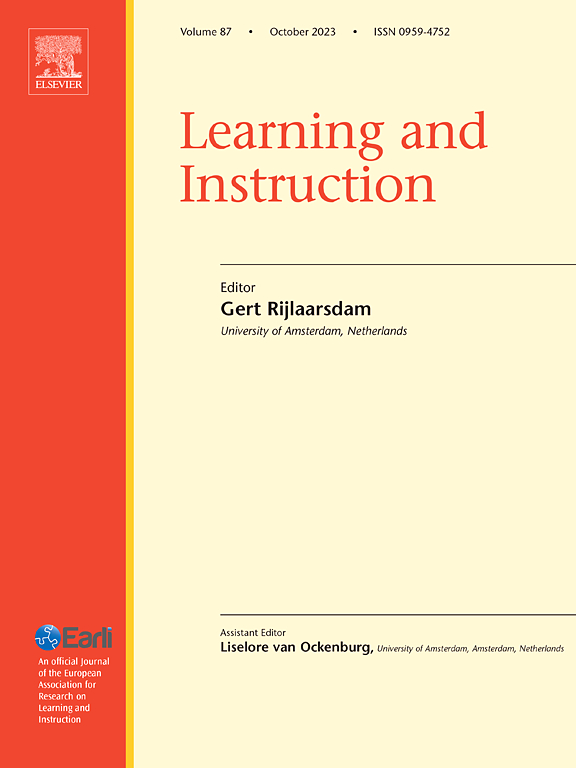三年级学生的数字和纸质文本理解
IF 4.9
1区 教育学
Q1 EDUCATION & EDUCATIONAL RESEARCH
引用次数: 0
摘要
研究表明,数字和纸质文本理解存在差异,但对小学生的研究有限,文本类型的作用仍不清楚。本研究考察了阅读媒介及其与文本体裁的交互作用对文本理解的影响,并探讨了这些影响是否随阅读理解技能、学术与休闲媒介偏好、计算机使用、工作记忆和注意力技能的控制而变化。方法对157名三年级学生(平均年龄8.40岁,SD = 0.30,女性48.41%)进行参与者内设计,阅读四种不同的文本:两种纸上线性文本(一种叙事文本和一种说明性文本)和两种屏幕线性文本(一种叙事文本和一种说明性文本)。参与者阅读四篇文章(两篇叙述性文章和两篇说明性文章),媒介(纸质数字;数字-纸)和文本类型(叙述-说明文;expository-narrative)。结果学生对叙事性文本的理解能力优于说明性文本。然而,无论学生的阅读理解能力或他们对电脑的偏好如何,阅读媒介及其与文本体裁的互动对理解结果没有显著影响。结论阅读媒介效应的缺失与先前的一些小学教育研究一致,尽管它与阅读媒介效应的荟萃分析结果存在差异。我们强调促进在后期学年战略性地使用数字设备进行阅读的重要性,以防止潜在的滥用,特别是在非生产性数字活动日益多样化的情况下。本文章由计算机程序翻译,如有差异,请以英文原文为准。
Third graders’ digital and paper text comprehension
Background
Research suggests differences in digital and paper text comprehension, but studies on primary school children are limited, and the role of textual genre remains unclear. This study examines the effects of reading medium and its interaction with text genre on text comprehension and explores whether these effects vary with comprehension skills, medium preference for academic vs leisure purposes, and computer use, controlling for working memory and attention skills.
Method
A within participants design was implemented with 157 third graders (mean age = 8.40, SD = 0.30, 48.41 % female) reading four different texts: two linear texts (one narrative and one expository) on paper and two other linear texts (one narrative and one expository) on screen. Participants read four texts (two narrative and two expository), with counterbalanced variations in medium (paper-digital; digital-paper) and textual genre (narrative-expository; expository-narrative).
Results
Students demonstrated better comprehension of narrative texts compared to expository ones. However, no significant effects on comprehension outcomes were observed for the reading medium or its interaction with text genre, regardless of students’ reading comprehension abilities or their preferred use of computers.
Conclusion
The absence of the reading medium effect aligns with some previous research in primary education, although it contrasts with meta-analytic findings on the effect of reading medium. We highlight the importance of promoting the strategic use of digital devices for reading in later school years to prevent potential misuse, especially as unproductive digital activities become increasingly diverse.
求助全文
通过发布文献求助,成功后即可免费获取论文全文。
去求助
来源期刊

Learning and Instruction
Multiple-
CiteScore
11.30
自引率
4.80%
发文量
109
期刊介绍:
As an international, multi-disciplinary, peer-refereed journal, Learning and Instruction provides a platform for the publication of the most advanced scientific research in the areas of learning, development, instruction and teaching. The journal welcomes original empirical investigations. The papers may represent a variety of theoretical perspectives and different methodological approaches. They may refer to any age level, from infants to adults and to a diversity of learning and instructional settings, from laboratory experiments to field studies. The major criteria in the review and the selection process concern the significance of the contribution to the area of learning and instruction, and the rigor of the study.
 求助内容:
求助内容: 应助结果提醒方式:
应助结果提醒方式:


